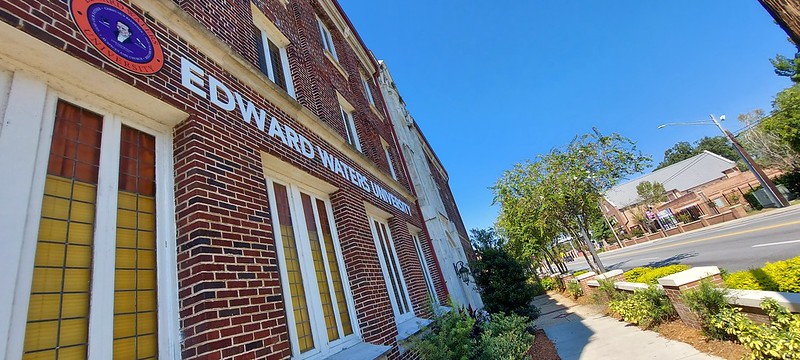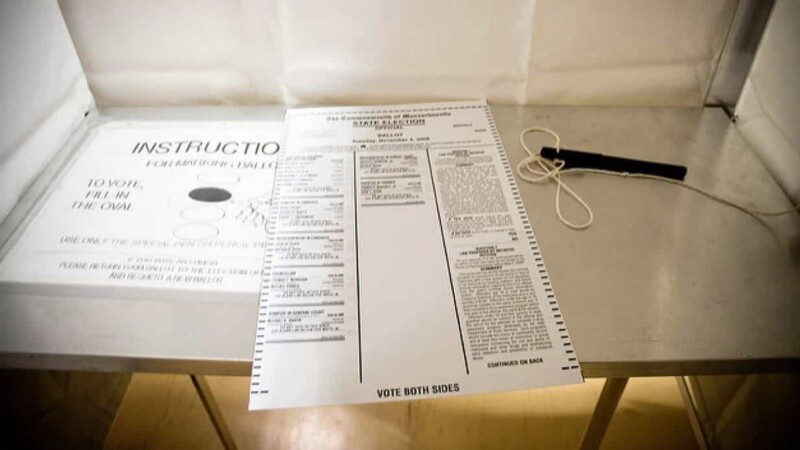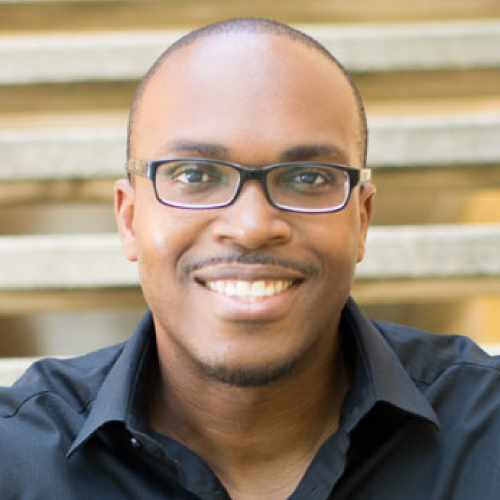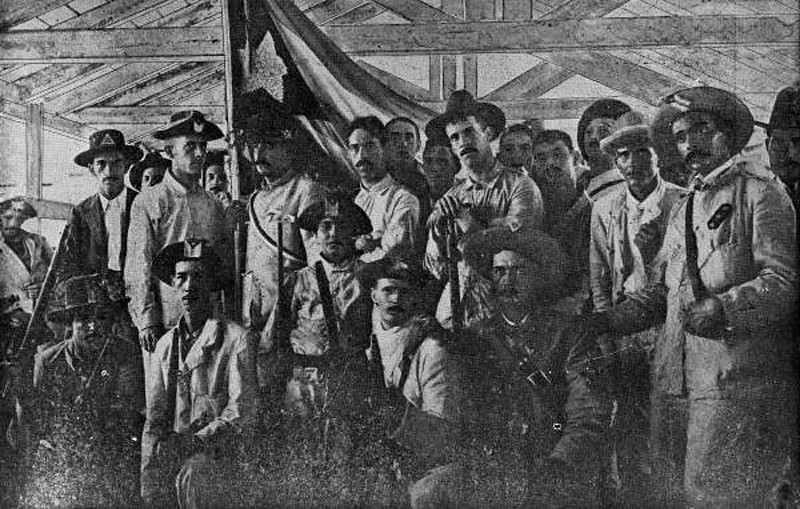
Located 2 miles northwest of Downtown, Edward Waters University is Jacksonville’s oldest institution of higher learning. The oldest portion of the urban university campus was added to the National Register of Historic Places as a historic district on August 8, 2022.
Edward Waters University history

Recognized as the first historic Black college in the state of Florida, Edward Waters University was initially founded in 1866 by the African Methodist Episcopal Church (AME). In continuous operation since 1883, the school was established to educate freedmen, women and their children.
The school’s original Downtown Jacksonville location was destroyed by the Great Fire of 1901. As a result, the school has been located at its present site since 1904. In addition to serving as a seminary for the AME Church in Florida, Edward Waters was for many years the only institution of higher learning available for African Americans in Jacksonville.
During the Great Depression, the campus served as the state “negro headquarters” for the National Youth Administration (NYA). Established in 1935 by the Franklin D. Roosevelt administration, the NYA Division of Negro Affairs was led by Mary McLeod Bethune.
Edward Waters University and civil rights
Founded during Reconstruction at a time when the AME Church was at the forefront of Black involvement in state and local politics, Edward Waters and its faculty, students, and alumni have a long history in racial uplift and civil rights activism at the local, state and national levels.
Perhaps the most famous alumnus was A. Philip Randolph, the founder and leader of the Brotherhood of Sleeping Car Porters and later one of the “Big Six” national civil rights leaders responsible for the organization of the 1963 March on Washington for Jobs and Freedom made famous by the Rev. Martin Luther King, Jr.’s “I Have a Dream” speech.
Other noted alumni include Samuel Decatur McGill, who represented the National Association of Colored People (NAACP) in its Florida cases in the 1930s and 1940s; Virgil Hawkins, whose groundbreaking civil rights case led to the eventual desegregation of the University of Florida’s law school; and Rodney Hurst and Marjorie Meeks, who led the local NAACP Youth Council during Jacksonville’s sit-in protests of the early 1960s.
The college also has a long association with the Jacksonville Branch of the NAACP, with multiple members of the faculty and administration serving in leadership roles. Among them was Edward Waters Music Director Theodore Luther Redding, who served as branch president in the 1940s and was responsible for the lawsuit that resulted in the desegregation of the local Democratic Party primaries in 1945.

Edward Waters today
In 2021, the college became Edward Waters University. Estimated to have 1,175 enrolled students for the fall 2023 semester, the school continues to witness record numbers in enrollment and retention.
Edward Waters University now offers bachelor’s degrees in several academic programs, including communications, music, psychology, criminal justice, accounting, biology, computer and information science, elementary education, forensic science, mathematics, public health, sports management and social work and business administration. The school also offers a master’s of business administration (MBA) and master’s in education policy and advocacy, public administration and cyber security.
The Edward Waters University historic district was listed on the National Register of Historic Places on August 8, 2022. Encompassing the historic core of the college campus, the 11.16-acre district consists of six contributing buildings.
Although the modern university campus extends into the surrounding neighborhoods and is bisected by Kings Road/U.S. Highway 23, the campus as a whole still conveys its historic feel as an early to mid-20th-century college campus. Here is a brief look at each contributing building’s history:
Centennial Hall (1916)

Completed in 1916 in commemoration of the 100th anniversary of the AME Church, Centennial Hall is the oldest remaining building on the campus of Edward Waters University. It was designed by Howells & Stockes, a renowned architectural firm based in New York City. It also represents a defining work of Richard Lewis Brown, a prominent local builder who later became Jacksonville’s first Black architect. Today, Centennial Hall serves as the library and classroom space for Edward Waters University.
B.F. Lee Theological Seminary and Milne Auditorium (1925)

Now known as the Lee-Cousins Building, the B.F. Lee Theological Seminary Building is a four-story brick structure prominently located along Kings Road. The building was designed by prominent local architectural firm Mark & Sheftall. Completed in 1925, it historically housed the AME seminary. Today, it serves primarily as the administrative offices for the university.
Adjacent to the B.F. Lee Theological Seminary, the Milne Auditorium is a two-story brick structure that features distinctive use of stained glass windows separated by prominent capped pilasters. Historically, the auditorium has served as an important gathering place and venue for the university. Events that took place during the civil rights era include a large gathering in 1955 where AME Bishop Frank Reid gave a scathing public rebuke of the attorney general of Georgia’s stance that Black public school teachers in that state could not belong to the NAACP.
Bishop Henry Tookes Building (1945)

The Bishop Henry Tookes Building is a one-story brick structure that is relatively restrained in appearance. It was designed by noted Black architect and builder James Edward Hutchins. After arriving in Jacksonville, Hutchins was a carpenter with the Dawkins Building and Supply Company several years before establishing his own construction company in the 1930s. One of the few local African-American contractors that also designed their buildings, Hutchins is responsible for several African American churches and residences in the College Gardens and Durkee Gardens subdivisions. Originally serving as the school’s library, the building was later expanded in 1955 with an addition designed by W. Kenyan Drake.
M. B. Salter Hall (1950)

Under the direction of Bishop M.B. Salter, who made education a priority during his time as the bishop of the Florida Conference, the original Salter Hall was built circa 1909. Functioning as a women’s dormitory, dining hall, and classroom building, the lumber used in its construction came from noted local Black architect and builder Joseph H. Blodgett. Unfortunately, the college experienced a devastating fire in April 1936, resulting in the original Salter Hall’s and an annex building’s destruction. In 1950, after several years of construction, the current M.B. Salter Hall building was completed on the site of the destroyed structure. Serving as a women’s dormitory, the two-story irregular L-shaped brick-veneered wood frame building features elements of the neoclassical revival style.
Hatcher-Stewart Science and Mathematics Building (1968)

Located at 1740 Kings Road at the intersection of Pearce Street, the Hatcher-Stewart Science and Mathematics Building is a 24,000-square-foot structure completed in 1968. The two-story reinforced concrete building with a yellow brick veneer has historically served as a major classroom building for Edward Waters University.
George N. Collins Student Center (1972)

The George N. Collins Student Center was designed by Boyer & Boyer, Architects and completed in 1972. The firm was owned and operated by David B. Boyer and Mary-Louise Boyer, a husband and wife team who both graduated from Harvard University and lived in Atlantic Beach. An excellent example of the international style of architecture adapted to an African American institution of higher learning, the Collins center is a large two-story reinforced concrete building with a large, overhanging flat roof and second-story veranda supported by exposed steel beams. Since its completion, the George N. Collins Student Center has served as the student union and cafeteria for the university.






